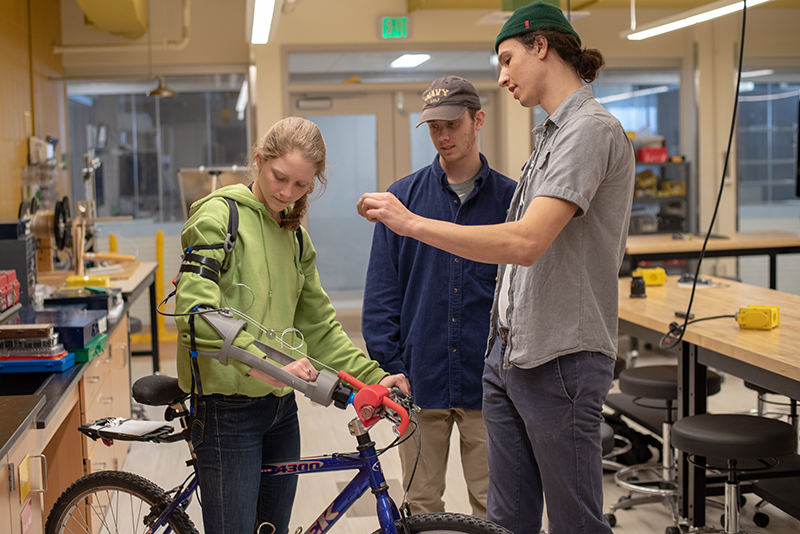Last September, a team of four UVM engineering students received a challenge from Nick Dechev, the executive director of the Victoria Hand Project: build two better hands—one for riding a bike and another for holding cutlery.
“We’re almost done,” says mechanical engineering major Katie Stokes. She holds up a red-and-purple plastic device with two finger-like extensions holding a fork firmly in their grip.
The Victoria Hand Project works with amputees in seven developing countries, from Haiti to Cambodia, using 3D printers to produce custom-fitted prosthetics—that local people can afford and local medical professionals can manufacture and service.
“The current models they produce are aesthetically pleasing, and are able to assist users with a broad range of tasks,” explains mechanical engineering major Alex Troche. The Victoria devices are also body-powered and able to be manufactured for about $80 worth of materials, key advantages in poorer parts of the world.
“But people have been asking for models that can do a better job of holding silverware and riding and braking on a bike,” says team member Josh Goodrich ‘19. He loosens a large purple plastic screw on one of the team’s prototypes and the fork slides out. “For this one, we went with a simple design. It’s pretty much just a clamp and it works very well.”
Into the world
A few minutes later, Katie Stokes straddles a mountain bike in the new senior design studio in UVM’s Votey Hall. She moves the muscles in her shoulder and back and a series of cables connected to a hand-like hook, attached to her arm, pulls on the brake lever. “We’re fine-tuning this biking one,” she explains. “We can get it to stop the bike wheel, but, when we’re actually riding, we’re still figuring out the best way to make it work.”
The four students have been working on these attachments—“that can be swapped out with the current Victoria Hand base models,” explains Troche—as their SEED project (for Senior Experience in Engineering Design). “It’s our capstone,” he says, “We’ve been working on it for two semesters and it brings together all our training.”
Bicycles are a crucial form of transportation in many developing countries. “But it’s pretty difficult to grip the handle bar and use the brake with the current hand,” says Goodrich. If the students succeed, their two new attachments will give the Victoria Hand Project some new options to offer clients. “The current Victoria models enable users to handle large objects like cups,” notes Troche, “but lack the combined force and dexterity required to handle silverware.”
When a person loses their hand or arm—perhaps to disease or warfare—they may face many challenges from writing to opening doors to getting a job. A well-engineered prosthetic can restore important capabilities—but in many developing countries, access to prosthetic care can be hard to find and good prosthetics too expensive. The Victoria Hand Project is working to overcome these challenges—and the UVM team’s academic task is to help out with a well-considered pair of prototypes, ready to present during the College of Engineering and Mathematical Sciences’ Senior Design Night on April 26. But the students’ most important test will come long after they’ve graduated, when people go to use the prosthetic hands they designed.
“We’re going to help people bike and eat,” says Katie Stokes, “and that feels good.”
Source: UVM News

